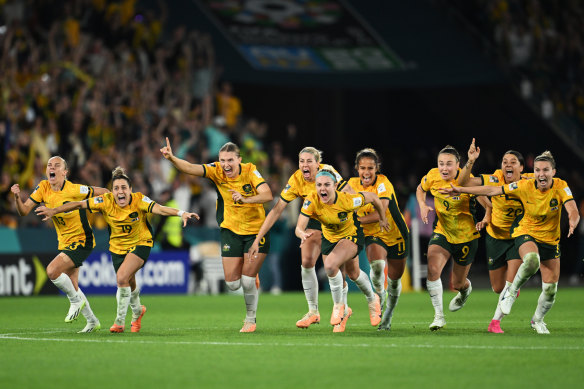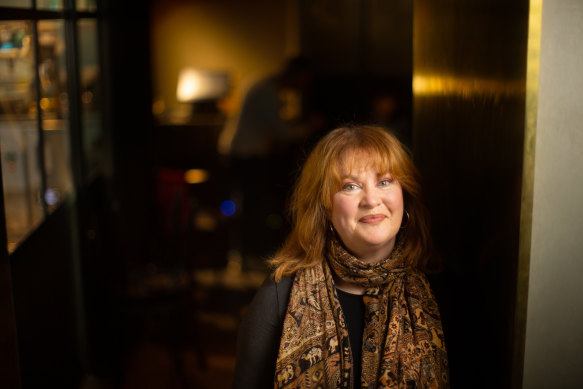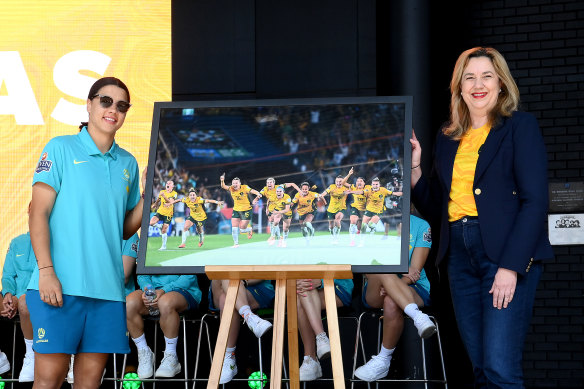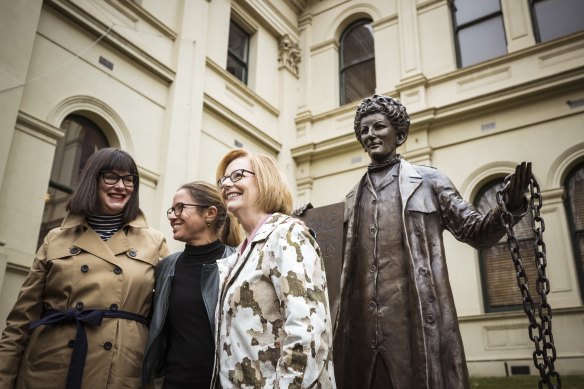Save articles for later
Add articles to your saved list and come back to them any time.
The Matildas may not have secured the bronze medal, but are now promised immortality in the very metal at their site of their World Cup heroics thanks to a grateful Queensland premier.
But Annastacia Palaszczuk’s joyful promise to the women’s soccer team would be very expensive and probably unworkable in its current form, according to one expert sculptor.
The Matildas celebrating Cortnee Vine’s matchwinning penalty against France.Credit: Getty
Bronze, the traditional material for such works, would be prohibitively expensive to use. A single statue of an individual can run at more than $150,000, depending on scale and complexity – and the image proposed has nine players in it.
The iconic photograph shows the group of Matildas streaming across the field – arms out, elated – celebrating Cortnee Vine’s matchwinning penalty against France that put Australia in its first World Cup semi-final.
Palaszczuk unveiled a plaque featuring the photo and promised a statue based on the image outside Brisbane’s Lang Park, already home to representations of male sports stars including Wally Lewis, Mal Meninga and John Eales.
Jennifer Mann, who has sculpted feminist activist Zelda D’Aprano and jockey Hugh Cairns, said she did not think the photograph identified by Palaszczuk would be realistic as a series of individual statue – and that it would detract from their depiction as a team.
Jennifer Mann says there’s an X-factor in what makes a sculpture resonate.Credit: Simon Schluter
“If she wants to replicate that whole melee of people, as a sculpture … I’m not quite sure how that photo would work,” she said.
Mann said one option would be a relief sculpture – a style in which the sculpted sections remain attached to a solid background of the same material – with a focus on Matildas skipper Sam Kerr.
“I would tackle that scene of jubilation of the whole team as a relief sculpture, as a life-sized piece,” she said. “What would be really fantastic is Sam [Kerr] coming out of that as a relief sculpture.”
Rather than feature Kerr snap frozen in a single athletic moment, as is common in statues of sportspeople – think Shane Warne or Betty Cuthbert at the MCG or Steve Waugh at SCG – Mann would show her focusing intensely.
Matildas captain Sam Kerr and Queensland Premier Annastacia Palaszczuk with the photograph the statue is to be based on.Credit: Bradley Kanaris
“I don’t see anything wrong with highlighting the captain as holding all the values [of the team]. I love that they were courageous but not aggressive.”
Mann said such a piece would tell a big picture story, acknowledging the spirit of the team and reflecting its history-making impact.
“A sculpture would remind generations to come that the success of the Matildas represented more than just sporting prowess,” she said.
“It’s a story of embracing and honouring the values they model like resilience, strength, courage, persistence, the joy of sport but also a compassionate approach to their opponents and expressing emotions. Things that we all loved seeing play out right in front of us as a nation.
“It would be good to have a statue of a woman alongside those of men already at the stadium.”
The Macedon Ranges-based artist makes sculptures and statues of real life people and wants to see values other than power – war, sporting prowess, politics – honoured.
“Our society is not just about power, it’s all sorts of wonderful things that people do, whose lives were devoted to things that we value.”
In Australia, statues of people generally celebrate those in power, which is why there are more of animals than women; less than 2 per cent of public statues in Victoria are of real-life women.
Former prime minister Julia Gillard (right) with Kristine Ziwica and Professor Clare Wright from A Monument of One’s Own, in front of Mann’s statue of activist Zelda D’Aprano at Trades Hall.Credit: Chris Hopkins
Mann sees a strong appetite for statues but to date sadly not for those of women.
“What’s really good now is there appears to be a huge groundswell of support for the idea of statue equality. Why shouldn’t we be looking around our public spaces and seeing inspirational women as well as men?
“Our public spaces should represent all of us as a society. When you scratch the surface and start to look at the histories of our amazing women, [Australian suffragette] Vida Goldstein is a shining star but there are so many.”
Mann has studied the intricacies of facial reconstruction with the people who teach the FBI.
“Building up from the skull, all of the musculature of the face, that’s one side of it, you have to be anatomically and proportionally correct,” she said, adding that those insights significantly impacted her work.
Mann said that the way we read faces was complex, even when they’re bronze or marble statues. Once the anatomy is correct, Mann aims to capture the essence of a person.
“A good likeness in sculptures of people’s faces depends on an X-factor that comes from within the sculptor,” she said. “It’s hard to describe, but a good likeness is something that everyone recognises.”
Find out the next TV, streaming series and movies to add to your must-sees. Get The Watchlist delivered every Thursday.
Most Viewed in Culture
From our partners
Source: Read Full Article



